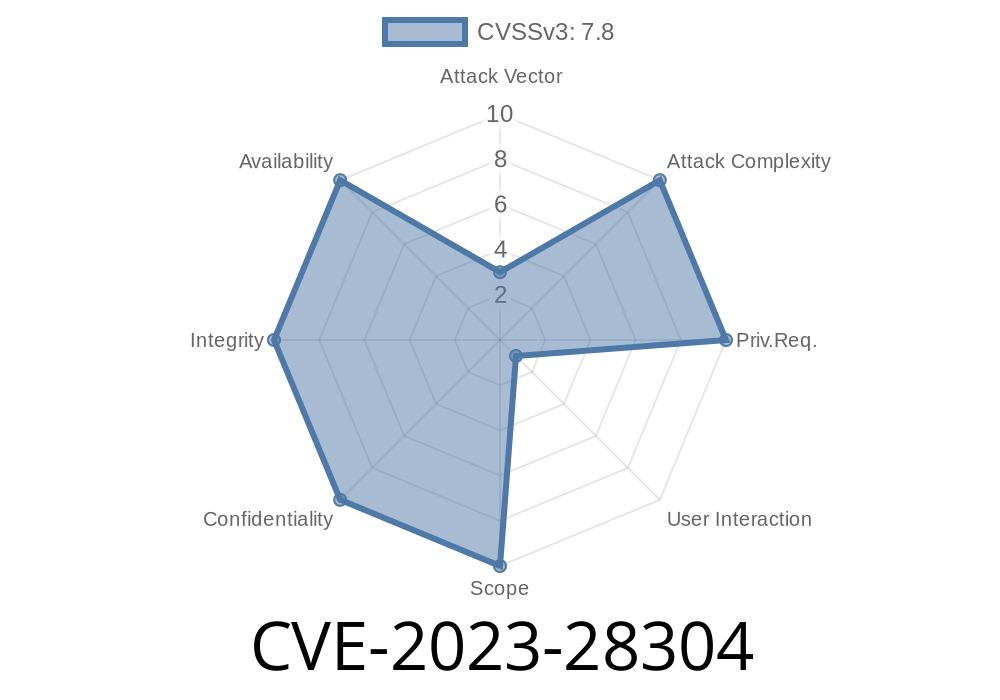Microsoft's ODBC and OLE DB are crucial components in many business and enterprise environments, as they provide a standard interface for connecting to SQL databases. Unfortunately, a significant vulnerability, CVE-2023-28304, has emerged, related to Microsoft ODBC (Open Database Connectivity) and OLE DB (Object Linking and Embedding, Database). This vulnerability allows remote code execution, which could result in data theft or complete control-of affected systems by attackers.
In this long-read post, we will take a closer look at CVE-2023-28304, delve into the exploit details, and provide code snippets and resources for further study.
CVE-2023-28304 Exploit Details
The vulnerability CVE-2023-28304 involves a flaw in how ODBC and OLE DB handle certain functions in the SQL driver, allowing an attacker to inject their malicious code. Successful exploitation of this vulnerability could result in remote code execution, enabling the attacker to execute arbitrary code in the context of the system user or even gain control of a vulnerable system.
The vulnerability affects all versions of Microsoft's Windows operating system, including its server platforms, and might lead to severe information disclosure, tampering with, or complete destruction of the system.
Original References
The vulnerability was first reported on the National Vulnerability Database (NVD), the primary authority on security vulnerabilities maintained by the United States government. The NVD provides comprehensive information about CVE-2023-28304, including descriptions, risk assessments, and possible mitigations. You may find the complete details on their webpage: CVE-2023-28304 NVD Entry
Microsoft has also acknowledged the vulnerability and published a security advisory to inform users about the possible exploitation, risk factors, and available patches. To access this advisory, please visit: Microsoft Security Advisory
Code Snippet
The vulnerability can be exploited by an attacker exploiting a vulnerable function in the SQL driver. The following example demonstrates a proof-of-concept that takes advantage of the vulnerability:
#include <stdio.h>
#include <windows.h>
#include <sqlext.h>
int main()
{
SQLHENV hEnv;
SQLHDBC hDbc;
SQLCHAR szOutConnStr[1024];
SQLSMALLINT cbOutConnStr;
SQLRETURN retcode;
retcode = SQLAllocHandle(SQL_HANDLE_ENV, SQL_NULL_HANDLE, &hEnv);
if (retcode == SQL_SUCCESS || retcode == SQL_SUCCESS_WITH_INFO)
{
retcode = SQLSetEnvAttr(hEnv, SQL_ATTR_ODBC_VERSION, (SQLPOINTER)SQL_OV_ODBC3, );
if (retcode == SQL_SUCCESS || retcode == SQL_SUCCESS_WITH_INFO)
{
retcode = SQLAllocHandle(SQL_HANDLE_DBC, hEnv, &hDbc);
if (retcode == SQL_SUCCESS || retcode == SQL_SUCCESS_WITH_INFO)
{
HWND desktopHandle = GetDesktopWindow();
retcode = SQLDriverConnect(hDbc, desktopHandle,
(SQLCHAR*)"DRIVER={SQL Server};"
"SERVER=127...1;"
"DATABASE=my_database;"
"UID=my_user;"
"PWD=my_password;",
SQL_NTS, szOutConnStr, 1024,
&cbOutConnStr, SQL_DRIVER_NOPROMPT);
if (retcode != SQL_SUCCESS || retcode != SQL_SUCCESS_WITH_INFO)
{
printf("Failed to connect to the database. Error code: %d\n", retcode);
}
}
}
});
// Malicious code injection and execution could occur here
SQLFreeHandle(SQL_HANDLE_DBC, hDbc);
SQLFreeHandle(SQL_HANDLE_ENV, hEnv);
return ;
}
Mitigations and Best Practices
Microsoft has released a patch to fix the vulnerability CVE-2023-28304 in the affected systems, and it is highly recommended to apply this patch immediately. You can download the patch on Microsoft Update Catalog
Apart from applying the patch, some other best practices to protect against this vulnerability include:
Conclusion
In our in-depth analysis of the CVE-2023-28304 vulnerability, we provided insight into how this exploit can be executed, shared information from the original references, and highlighted the code snippet associated with the vulnerability. We also emphasized the importance of applying Microsoft's patch to minimize the risk of exploitation.
It is crucial to remain vigilant and proactive in securing systems against vulnerabilities like CVE-2023-28304, as preventing remote code execution is not only essential to maintain data integrity but also to avoid potential system compromises.
Timeline
Published on: 04/11/2023 21:15:00 UTC
Last modified on: 04/19/2023 20:19:00 UTC
